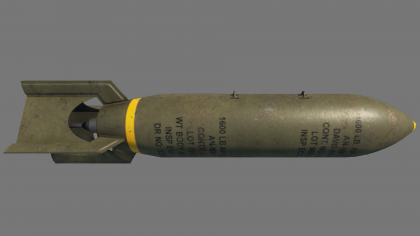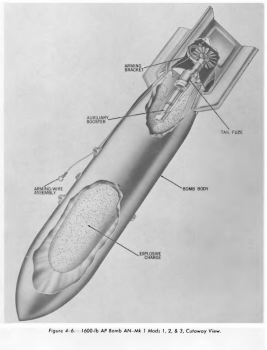Difference between revisions of "AN-Mk 1 (1,600 lb)"
U129399737 (talk | contribs) (→Pros and cons) (Tag: Visual edit) |
|||
| (8 intermediate revisions by 5 users not shown) | |||
| Line 8: | Line 8: | ||
<!-- ''List out vehicles that are equipped with the weapon.'' --> | <!-- ''List out vehicles that are equipped with the weapon.'' --> | ||
| − | + | {{Navigation-Start|Vehicles equipped with this weapon}} | |
| − | + | ||
| − | + | {{Navigation-First-Line|'''Fighters'''}}{{Specs-Link|f6f-3}}{{-}}{{Specs-Link|f6f-5_france}}{{-}}{{Specs-Link|hellcat_fmk1}} | |
| − | + | ||
| − | + | {{Navigation-First-Line|'''Twin-engine fighters'''}}{{Specs-Link|f7f3}} | |
| − | + | ||
| − | + | {{Navigation-First-Line|'''Strike aircraft'''}} | |
| − | + | {{Navigation-Line|AD-2}}{{Specs-Link|douglas_ad_2}} | |
| − | + | {{Navigation-Line|AD-4}}{{Specs-Link|douglas_ad_4}}{{-}}{{Specs-Link|douglas_ad_4_france}}{{-}}{{Specs-Link|douglas_ad_4na_france}} | |
| + | {{Navigation-Line|AM-1}}{{Specs-Link|am_1_mauler}} | ||
| + | {{Navigation-Line|AU-1}}{{Specs-Link|f4u-6_au-1}} | ||
| + | {{Navigation-Line|PBJ-1}}{{Specs-Link|pbj_1h}}{{-}}{{Specs-Link|pbj_1j}} | ||
| + | |||
| + | {{Navigation-First-Line|'''Bombers'''}} | ||
| + | {{Navigation-Line|B-17}}{{Specs-Link|b-17g}} | ||
| + | {{Navigation-Line|B-24}}{{Specs-Link|b_24d}} | ||
| + | {{Navigation-Line|B-26}}{{Specs-Link|b_26b_c}}{{-}}{{Specs-Link|b_26c_france}} | ||
| + | {{Navigation-Line|BTD-1}}{{Specs-Link|btd-1}} | ||
| + | {{Navigation-Line|PBM}}{{Specs-Link|pbm_1}}{{-}}{{Specs-Link|pbm_3}}{{-}}{{Specs-Link|pbm_5a}} | ||
| + | {{Navigation-Line|SB2C}}{{Specs-Link|sb2c_4}} | ||
| + | {{Navigation-Line|SB2U}}{{Specs-Link|sb2u-2}}{{-}}{{Specs-Link|sb2u-3}} | ||
| + | {{Navigation-Line|SBD-3}}{{Specs-Link|sbd-3}} | ||
| + | {{Navigation-Line|TBF-1}}{{Specs-Link|tbf-1c}}{{-}}{{Specs-Link|avenger_mk1}} | ||
| + | |||
| + | {{Navigation-End}} | ||
== General info == | == General info == | ||
| Line 41: | Line 57: | ||
=== Effective damage === | === Effective damage === | ||
| − | '' | + | ''Describe the type of damage produced by this type of bomb (high explosive, splash damage, etc)'' |
=== Comparison with analogues === | === Comparison with analogues === | ||
| Line 47: | Line 63: | ||
== Usage in battles == | == Usage in battles == | ||
| − | '' | + | ''Describe situations when you would utilise this bomb in-game (vehicle, pillbox, base, etc)'' |
=== Pros and cons === | === Pros and cons === | ||
| Line 53: | Line 69: | ||
'''Pros:''' | '''Pros:''' | ||
| − | |||
| − | |||
| − | |||
| − | |||
| − | |||
| − | |||
* | * | ||
'''Cons:''' | '''Cons:''' | ||
| − | |||
| − | |||
| − | |||
| − | |||
* | * | ||
| Line 115: | Line 121: | ||
* War Department. 1944. ''TM 9-1904: Ammunition Inspection Guide''. New Jersey: Raritan Arsenal. | * War Department. 1944. ''TM 9-1904: Ammunition Inspection Guide''. New Jersey: Raritan Arsenal. | ||
| − | {{ | + | {{AP bombs}} |
[[Category:Suspended armaments]] | [[Category:Suspended armaments]] | ||
Latest revision as of 18:47, 14 August 2024
Contents
Description
The 1,600 lb AN-Mk 1 is an American armour-piercing bomb.
Vehicles equipped with this weapon
| Vehicles equipped with this weapon | |
|---|---|
| Fighters | F6F-5 · ▄F6F-5 · ▄Hellcat Mk II |
| Twin-engine fighters | F7F-3 |
| Strike aircraft | |
| AD-2 | AD-2 |
| AD-4 | AD-4 · ▄AD-4 · ▄AD-4NA |
| AM-1 | AM-1 |
| AU-1 | AU-1 |
| PBJ-1 | PBJ-1H · PBJ-1J |
| Bombers | |
| B-17 | B-17G-60-VE |
| B-24 | B-24D-25-CO |
| B-26 | B-26B · B-26C |
| BTD-1 | BTD-1 |
| PBM | PBM-1 "Mariner" · PBM-3 "Mariner" · PBM-5A "Mariner" |
| SB2C | SB2C-4 |
| SB2U | SB2U-2 · SB2U-3 |
| SBD-3 | SBD-3 |
| TBF-1 | TBF-1C · ▄Avenger Mk II |
General info
| Bomb characteristics | |
|---|---|
| Mass | 721.2 kg (1,590 lbs) |
| Explosive mass | 97.5 kg |
| Explosive type | Explosive D |
| TNT equivalent | 95.55 kg |
| HE max penetration | 78 mm |
| Armour destruction radius | 6 m |
| Fragment dispersion radius | 100 m |
Effective damage
Describe the type of damage produced by this type of bomb (high explosive, splash damage, etc)
Comparison with analogues
Give a comparative description of bombs that have firepower equal to this weapon.
Usage in battles
Describe situations when you would utilise this bomb in-game (vehicle, pillbox, base, etc)
Pros and cons
Summarise and briefly evaluate the weaponry in terms of its characteristics and combat effectiveness. Mark pros and cons as a list.
Pros:
Cons:
History
The AN-Mk 1 bomb was in United States service during World War II, seeing use sometime prior to 1944. Used between the United States Army and Navy (hence the AN designation), its purpose is to penetrate the horizontal armour of enemy naval ships and detonate below deck. To permit the bomb to penetrate, the bomb wall is comparatively thick to general-purpose bomb, and results in a smaller explosive cavity.[1]
The bomb's design is cylindrical with a pointed nose, the tail is tapered and a box-type fin assembly is utilized. The bomb diameter is 14 inches (~35.6 cm) and the length 83.5 inches (~212 cm). The total weight of the bomb is 1,590 lbs, with an internal explosive capacity of 209 lbs of explosive D.[2] The bomb used the following components: Mk 1 (or AN-M6A2) arming-wire assembly, Mk 1 arming bracket, Mk 1 Mod 0 auxiliary booster, and the AN-Mk 228 tail fuse with a 0.08 second delay. The bomb comes painted in olive drab, with identifying nomenclature and other data painted on the bomb body [3][4]
Three modifications of the AN-Mk 1 regarding the method of attachment of suspension accessories are noted under the following designations:[1]
- Mark I: Has two suspension bands and one hoisting band, with a locating stud on the inside of each band to engage a recess in the bomb body.
- Mark I (or early lot AN-Mk 1): Has same number of bands, but are connected by shallow grooves machined in the bomb body, with the grooves spaced out for 14-inch racks and 30-inch racks.
- AN-Mk 1: Changed design with bands changed into lugs and bolts intended to attach to blind holes built into the bomb body.
Although different Mod numbers are identified for the AN-Mk 1 (Mod 1, 2, 3), there are no physical or component differences in the bomb design as the Mods only identify the manufacturers.[3]
The bomb was made obsolete sometime prior to 1960.[3]
Media
Excellent additions to the article would be video guides, screenshots from the game, and photos.
See also
Links to the articles on the War Thunder Wiki that you think will be useful for the reader, for example:
- reference to the article about the variant of the weapon;
- references to approximate analogues by other nations and research trees.
External links
References
- Citations
- Bibliography
- Chief of the Bureau of Naval Weapons. 1960. NAVWEPS OP 2216 (Volume 1): Aircraft Bombs, Fuzes and Associated Components. Washington DC: U.S. Government Publishing Office.
- Gervasi, Tom. 1984. America's War Machine: The Pursuit of Global Dominance: Arsenal of Democracy III. New York: Grove Press, Inc.
- US Navy Bomb Disposal. 1945 United States Bombs and Fuzes Pyrotechnics. Washington DC: U.S. Government Publishing Office.
- War Department. 1944. TM 9-1904: Ammunition Inspection Guide. New Jersey: Raritan Arsenal.
| Armour-piercing bombs | |
|---|---|
| USA | |
| 1,000 lb | A.P. AN-MK 33 |
| 1,600 lb | AN-Mk 1 |
| Germany | |
| 10 kg | SD10C |
| 50 kg | SD50 |
| 70 kg | SD70 |
| 500 kg | PC500 |
| 1,000 kg | PC1000 |
| 1,045 kg | HS 293 A-1* |
| 1,400 kg | PC 1400 X* |
| 1,600 kg | PC1600 |
| USSR | |
| 220 kg | BRAB-220 (1930) |
| 250 kg | BRAB-250 |
| 500 kg | BRAB-500 (1938) · BRAB-500 |
| 1,000 kg | BRAB-1000 (1938) · BRAB-1000 |
| Britain | |
| 500 lb | S.A.P. Mk.II |
| 2,000 lb | A.P. Mk.I |
| Japan | |
| 500 kg | Number Type 2 50 Model 1 GP(SAP) |
| 800 kg | Navy Type 99 Number 80 AP |
| 1,500 kg | Navy Type 3 Number 150 AP |
| Italy | |
| 160 kg | A.P 160 |
| 630 kg | 630 P.D. |
| * Guided bomb | |
| See also | List of high-explosive, unguided, free-falling bombs · List of guided bombs · List of retarded bombs |





